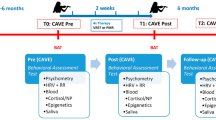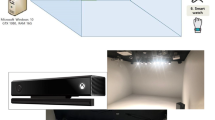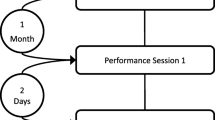Abstract
Virtual reality exposure is increasingly used as a method of treatment for anxiety disorders. This exploratory study examines a virtual reality exposure training (VRET) conceived for the treatment of music performance anxiety (MPA). The aim is to obtain first-level knowledge in the music field concerning VRET. This article analyzes how MPA, concentration and quality of performance evolve during VRET. Nine music students participated in six 1-h sessions of VRET spread out over 3 weeks. They were exposed to four different virtual environments representing typical audiences for musicians. The findings indicate a significant decrease in MPA between sessions. They also indicate a significant increase in performance quality within sessions and a positive correlation between absorption ability and level of anxiety at the beginning of the VRET. Further studies must be conducted to evaluate the generalizability potential of these results to real performance situations.



Similar content being viewed by others
Abbreviations
- VRET:
-
Virtual reality exposure training
- MPA:
-
Music performance anxiety
- VR:
-
Virtual reality
References
Anderson P (2007) Usability and utility of a computerized cognitive-behavioral self-help program for public speaking anxiety. Cogn Behav Pract 14:198–207
Appel SS (1974) Modifying solo performance anxiety in adult pianists. Columbia University, New York
Baños RM, Botella C, Garcia-Palacios A, Villa H, Perpiña C, Gallardo M (1999) Psychological variables and reality judgment in virtual environments: the roles of absorption and dissociation. Cyberpsychol Behav 2(2):143–148
Bissonnette J, Dubé F, Provencher MD, Moreno Sala MT (2015) Virtual reality exposure training for musicians: Its effect on performance anxiety and quality. Med Probl Perform Artist 30(3):169–177
Bouchard S (2007) Efficacité d’un traitement d’exposition en réalité virtuelle pour le traitement de l’arachnophobie chez l’enfant une étude pilote. Journal de Thérapie Comportementale et Cognitive 17(3):101–108
Bouchard S, Robillard G, Paquin B, St-Jaques J (2003) Programme cognitivo-comportemental pour le traitement de la phobie spécifique via l’exposition en réalité virtuelle: Manuel du thérapeute. Laboratoire de Cyberpsychologie de l’UQO, Gatineau
Cohen J (1988) Statistical power analysis for behavioral sciences, 2nd edn. L Erlbaum associates, Hillsdale, NJ
Crawford CR (2011) Effects of exposure to virtual audience environments on performing musicians. McGill University, Montreal
Deacon BJ, Abramovitz A (2004) Cognitive and behavioral treatments for anxiety disorders: a review of meta-analytic findings. J Clin Psychol 60(4):429–441
Emmelkamp PM (2003) Behavior therapy with adults. In: Lambert M (ed) Handbook of psychotherapy and behavior change, 5th edn. Wiley, New York, pp 393–446
Foa EB, Kozak MJ (1986) Emotional processing of fear: exposure to corrective information. Psychol Bull 99(1):20–35
Foa EB, Huppert JD, Cahill SP (2006) Emotional processing theory: an update. In: Rothbaum BO (ed) Pathological anxiety. The Guilford Press, New York, pp 3–24
Harris SR, Kemmerling RL, North MM (2002) Brief virtual reality therapy for public speaking anxiety. Cyberpsychol Behav 5(6):543–550
Hayes SA, Hope DA, Heimberg RG (2008) The pattern of subjective anxiety during in-session exposures over the course of cognitive-behavioral therapy for clients with social anxiety disorder. Behav Ther 39(3):286–299
Kendrick MJ, Craig KD, Lawson DM, Davidson PO (1982) Cognitive and behavioral therapy for musical performance anxiety. J Consult Clin Psychol 50(3):353–362
Kenny DT (2011) The psychology of music performance anxiety. Oxford University Press, New York, p 365
Klinger E, Bouchard S, Légeron P, Roy S, Lauer F, Chemin I, Nugues P (2005) Virtual reality therapy versus cognitive behavior therapy for social phobia: a preliminary controlled study. Cyberpsychol Behav 8(1):76–88
Kosslyn SM, Brunn J, Cave KR, Wallach RW (1984) Individual differences in mental imagery ability: a computational analysis. Cognition 18:195–243
Krijn M, Emmelkamp PMG, Olafsson RP, Biemond R (2004) Virtual reality exposure therapy of anxiety disorders: a review. Clin Psychol Rev 24:259–281
Lang P (1971) The application of psychophysiological methods to the study of psychotherapy and behaviour modification. In: Bergin A, Garfield S (eds) Handbook of psychotherapy and behaviour change. Wiley, New York
McGinnis AM, Milling LS (2005) Psychological treatment of musical performance anxiety: current status and future directions. Psychother Theory Res Pract Train 3(42):357–373
Mystowski JL, Craske MG, Echiverri AM (2002) Treatment context and return of fear in spider phobia. Behav Ther 33:399–416
Orman EK (2003) Effect of virtual reality graded exposure on heart rate and self-reported anxiety levels of performing saxophonists. J Res Music Educ 51(4):302–315
Orman EK (2004) Effect of virtual reality graded exposure on anxiety levels of performing musicians: a case study. J Music Ther 41(1):70–78
Parsons TD, Rizzo AA (2008) Affective outcomes of virtual reality exposure therapy for anxiety and specific phobias: a meta-analysis. J Behav Ther Exp Psychiatry 39(3):250–261
Powers MB, Emmelkamp PM (2008) Virtual reality exposure therapy for anxiety disorders: a meta-analysis. J Anxiety Disord 22(3):561–569
Robillard G, Bouchard S, Renaud P, Cournoyer LG (2002) Validation canadienne-française de deux mesures importantes en réalité virtuelle: L’immersive Tendencies Questionnaire et le Presence Questionnaire. In: 25e congrès annuel de la Société Québécoise pour la Recherche en Psychologie (SQRP), Trois-Rivières
Roy S, Klinger E, Légeron P, Lauer F, Chemin I, Nugues P (2003) Definition of a VR-based protocol to treat social phobia. Cyberpsychol Behav 6(4):411–420
Salmon PG (1990) A psychological perspective on musical performance anxiety: a review of the literature. Med Probl Perform Artist 5:2–11
Steptoe A (2001) Negative emotions in music making: the problem of performance anxiety. In: Juslin PN, Sloboda JA (eds) Music and emotion: theory and research. Oxford University Press, New York, pp 291–307
Tellegen A, Atkinson G (1974) Openness to absorbing and self-altering experiences (“absorption”): a trait related to hypnotic susceptibility. J Abnorm Psychol 83(3):268–277
Van Kemenade JF, Van Son MJ, Van Heesch NC (1995) Performance anxiety among professional musicians in symphonic orchestras: a self-report study. Psychol Rep 77(2):555–562
Wiederhold BK, Wiederhold MD (2005) Vitual reality therapy for anxiety disorders: advances in evaluation and treatment. American Psychological Association, Washington
Wolpe JD, Lazarus AA (1966) Behavioral therapy techniques: a guide to the treatment of neuroses. Pergamon Press. Inc, Elmsford
Acknowledgments
We thank the “Fonds québécois de la recherche sur la société et la culture,” the Social Sciences and Humanities Research Council of Canada, and the Desjardins Foundation for their financial contribution to the realization of this study. We also thank the “Laboratoire de muséologie et d’ingénierie de la culture” for its material and financial contribution to the study.
Author information
Authors and Affiliations
Corresponding author
Rights and permissions
About this article
Cite this article
Bissonnette, J., Dubé, F., Provencher, M.D. et al. Evolution of music performance anxiety and quality of performance during virtual reality exposure training. Virtual Reality 20, 71–81 (2016). https://doi.org/10.1007/s10055-016-0283-y
Received:
Accepted:
Published:
Issue Date:
DOI: https://doi.org/10.1007/s10055-016-0283-y




